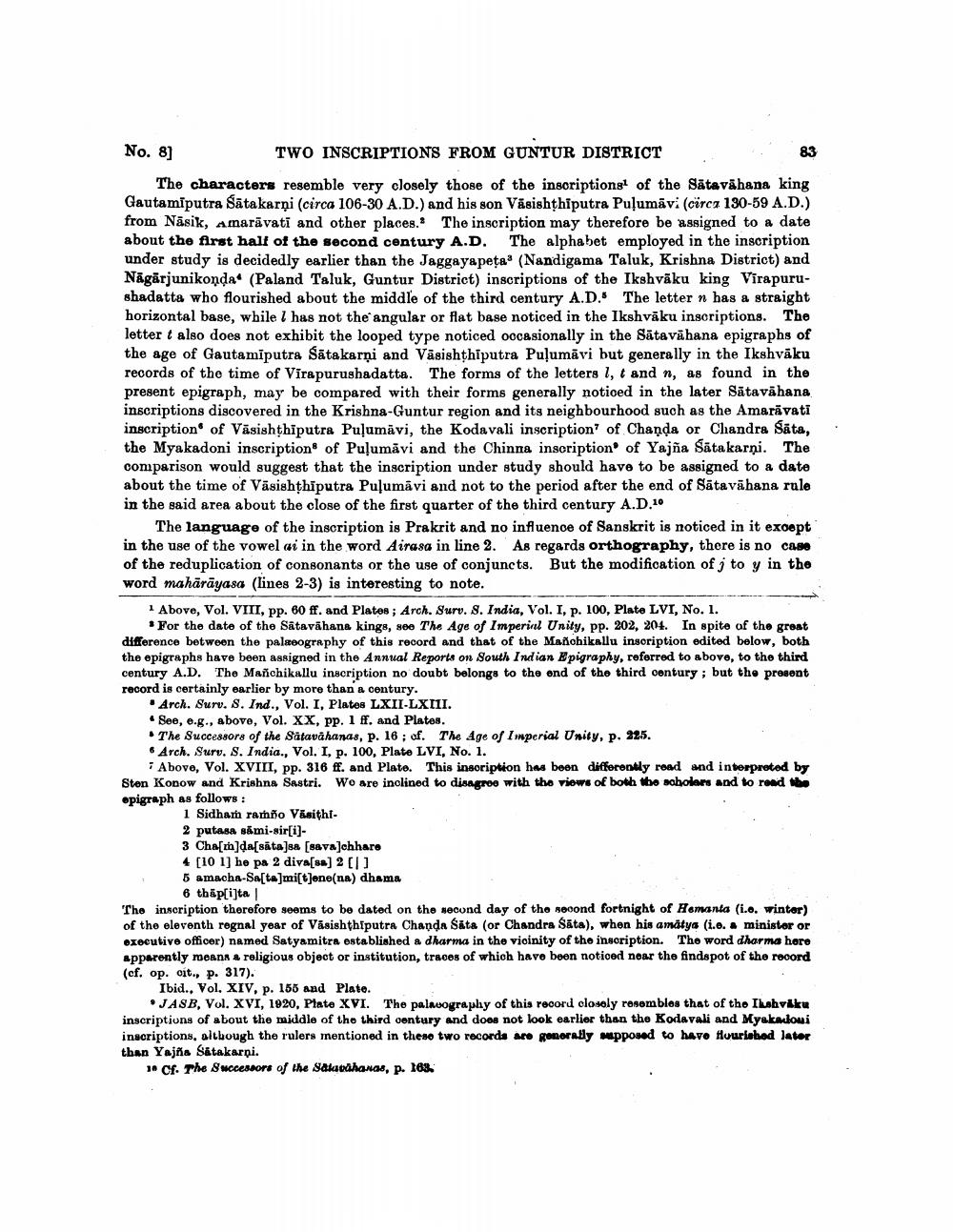________________
No. 8]
TWO INSCRIPTIONS FROM GUNTUR DISTRICT
83
The characters resemble very closely those of the inscriptions of the Sātavāhana king Gautamiputra Satakarni (circa 106-30 A.D.) and his son Väsishthiputra Puļumāvi (circa 130-59 A.D.) from Nasik, Amarāvati and other places. The inscription may therefore be assigned to a date about the first half of the second century A.D. The alphabet employed in the inscription under study is decidedly earlier than the Jaggayapeta (Nandigama Taluk, Krishna District) and Nägärjunikonda (Paland Taluk, Guntur District) inscriptions of the Ikshvāku king Virapurushadatta who flourished about the middle of the third century A.D." The letter n has a straight horizontal base, while l has not the angular or flat base noticed in the Ikshvāku inscriptions. The letter t also does not exhibit the looped type noticed occasionally in the Sātavāhana epigraphs of the age of Gautamīputra Satakarni and Väsishthiputra Puļumāvi but generally in the Ikshväku records of the time of Virapurushadatta. The forms of the letters 1, t and n, as found in the present epigraph, may be compared with their forms generally noticed in the later Sātavāhana inscriptions discovered in the Krishna-Guntur region and its neighbourhood such as the Amarāvati inscription of Vāsishthiputra Puļumāvi, the Kodavali inscription' of Chanda or Chandra Sāta, the Myakadoni inscription of Puļumāvi and the Chinna inscription of Yajña Sāta karņi. The comparison would suggest that the inscription under study should have to be assigned to a date about the time of Vāsishthiputra Pulumavi and not to the period after the end of Sātavāhana rule in the said area about the close of the first quarter of the third century A.D.10
The language of the inscription is Prakrit and no influence of Sanskrit is noticed in it except in the use of the vowel ai in the word Airasa in line 2. As regards orthography, there is no case of the reduplication of consonants or the use of conjuncts. But the modification of j to y in the word mahārāyasa (lines 2-3) is interesting to note.
1 Above, Vol. VIII, pp. 60 ff. and Plates; Arch. Sury. 8. India, Vol. I, p. 100, Plate LVI, No. I.
. For the date of the Sātavāhana kings, see The Age of Imperial Unity, pp. 202, 204. In spite of the great difference between the palaeography of this record and that of the Manohikallu insoription edited below, both the epigraphs have been assigned in the Annual Reports on South Indian Epigraphy, referred to above, to the third century A.D. The Manchikallu inscription no doubt belongs to the end of the third century; but the present record is certainly earlier by more than a century.
. Arch. Surv, S. Ind., Vol. I, Plates LXII-LXIII. . See, e.g., above, Vol. XX, pp. 1 ff. and Plates.
The Successors of the Satavahanas, p. 16; of. The Age of Inperial Unity, p. 325. 6 Arch. Surv. S. India., Vol. I, p. 100, Plate LVI, No. 1.
i Above, Vol. XVIII, pp. 316 ff. and Plate. This insoription has been differently read and interpreted by Sten Konow and Krishna Sastri. Wo are inclined to disagree with the viows of both the scholars and to read the epigraph as follows:
1 Sidham ranño Vásithi2 putasa sami-sir[i]3 Cha[m]da[sāta]sa (sava]chhare 4 [10 1] he pa 2 diva[sa] 2 [1] 5 amacha-Sastemitjene(na) dhama
| 6 thẸP[i]ta | The inscription therefore seems to be dated on the second day of the second fortnight of Hemanta (i.o. winter) of the eleventh regnal year of Vásishthiputra Chanda Sata (or Chandra Sāta), when his amatya (i.e. a minister or executive officer) named Satyamitra ostablished a dharma in the vioinity of the inscription. The word dharma hore apparently means a religious object or institution, traces of which have been noticed noar the findspot of the record (cf. op. cit., p. 317).
Ibid., Vol. XIV, p. 155 and Plate.
JASB, Vol. XVI, 1920, Plate XVI. The palacography of this record closely resembles that of the Ilahviku inscriptions of about the middle of the third century and does not look earlier than the Kodavali and Myakantowi inscriptions, although the rulers mentioned in these two records are generally apposed to have fuurishod later tban Yajña Satakarni.
1. Cf. The successors of the Salavahanas, p. 168




